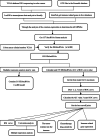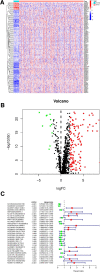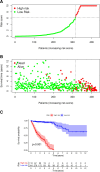Construction of a new immune-related lncRNA model and prediction of treatment and survival prognosis of human colon cancer
- PMID: 35249533
- PMCID: PMC8900415
- DOI: 10.1186/s12957-022-02508-2
Construction of a new immune-related lncRNA model and prediction of treatment and survival prognosis of human colon cancer
Abstract
Background: An increasing number of studies have shown that immune-related long noncoding RNAs (lncRNAs) do not require a unique expression level. This finding may help predict the survival and drug sensitivity of patients with colon cancer.
Methods: We retrieved original transcriptome and clinical data from The Cancer Genome Atlas (TCGA), sorted the data, differentiated mRNAs and lncRNAs, and then downloaded immune-related genes. Coexpression analysis predicted immune-related lncRNAs (irlncRNAs) and univariate analysis identified differentially expressed irlncRNAs (DEirlncRNAs). We have also amended the lasso pending region. Next, we compared the areas under the curve (AUCs), counted the Akaike information standard (AIC) value of the 3-year receiver operating characteristic (ROC) curve, and determined the cutoff point to establish the best model to differentiate the high or low disease risk group of colon cancer patients.
Results: We reevaluated the patients regarding the survival rate, clinicopathological features, tumor-infiltrating immune cells, immunosuppressive biomarkers, and chemosensitivity. A total of 155 irlncRNA pairs were confirmed, 31 of which were involved in the Cox regression model. After the colon cancer patients were regrouped according to the cutoff point, we could better distinguish the patients based on adverse survival outcomes, invasive clinicopathological features, the specific tumor immune cell infiltration status, high expression of immunosuppressive biomarkers, and low chemosensitivity.
Conclusions: In this study, we established a characteristic model by pairing irlncRNAs to better predict the survival rate, chemotherapy efficacy, and prognostic value of patients with colon cancer.
Keywords: Colon cancer; Immunotherapy; Tumor-infiltrating immune cell; lncRNA.
© 2022. The Author(s).
Conflict of interest statement
The authors declare that they have no competing interests.
Figures






Similar articles
-
Identification of Immune-Related lncRNA Pairs and Construction and Validation of a New Prognostic Signature of Colon Cancer.Can J Gastroenterol Hepatol. 2022 Mar 30;2022:5827544. doi: 10.1155/2022/5827544. eCollection 2022. Can J Gastroenterol Hepatol. 2022. PMID: 35399646 Free PMC article.
-
Construction of a novel immune-related lncRNA signature and its potential to predict the immune status of patients with hepatocellular carcinoma.BMC Cancer. 2021 Dec 19;21(1):1347. doi: 10.1186/s12885-021-09059-x. BMC Cancer. 2021. PMID: 34923955 Free PMC article.
-
Construction of a Novel Immune-Related lncRNA Pair Signature with Prognostic Significance for Kidney Clear Cell Renal Cell Carcinoma.Dis Markers. 2021 Sep 1;2021:8800358. doi: 10.1155/2021/8800358. eCollection 2021. Dis Markers. 2021. PMID: 34512816 Free PMC article.
-
Construction of immune-related lncRNA signature to predict aggressiveness, immune landscape, and drug resistance of colon cancer.BMC Gastroenterol. 2022 Mar 17;22(1):127. doi: 10.1186/s12876-022-02200-5. BMC Gastroenterol. 2022. PMID: 35300596 Free PMC article.
-
Identification of a novel immune-related long noncoding RNA signature to predict the prognosis of bladder cancer.Sci Rep. 2022 Mar 2;12(1):3444. doi: 10.1038/s41598-022-07286-1. Sci Rep. 2022. PMID: 35236887 Free PMC article.
Cited by
-
Construction and verification of a novel circadian clock related long non-coding RNA model and prediction of treatment for survival prognosis in patients with hepatocellular carcinoma.BMC Cancer. 2023 Jan 17;23(1):57. doi: 10.1186/s12885-023-10508-y. BMC Cancer. 2023. PMID: 36647032 Free PMC article.
References
-
- Cross AJ, Wooldrage K, Robbins EC, Kralj-Hans I, MacRae E, Piggott C, et al. Faecal immunochemical tests (FIT) versus colonoscopy for surveillance after screening and polypectomy: a diagnostic accuracy and cost-effectiveness study. Gut. 2019;68(9):1642–1652. doi: 10.1136/gutjnl-2018-317297. - DOI - PMC - PubMed
MeSH terms
Substances
LinkOut - more resources
Full Text Sources

